Writing your first paper in MLA format can be a bit scary. Use this simple yet comprehensive MLA style guide on all things MLA 8 to take you through the step-by-step process of creating your MLA paper. Use the MLA citation generator to create a detailed works cited page with properly formatted MLA citations. The comprehensive examples and illustrations ensure you don’t get led astray in your MLA format essay.
Table of Contents
What Is the MLA Style Guide?
To understand what the MLA style guide is, just look to who it was made by. MLA is the acronym for Modern Language Association. Therefore, it’s an academic writing guide created and designed specifically for language and liberal arts essays and papers. Unlike the American Psychological Association, which focuses on social sciences, MLA format and citations work to make liberal arts, humanities, language arts, and cultural studies papers a breeze. If that is the topic of your paper, this is your style guide.

Why Use MLA Style Guide?
The reason why you would use an MLA style guide to write your paper is simple; your language arts papers are going to be 5-10 pages and use dozens of sources. Therefore, you’re going to need to use some kind of organization system to keep everything straight. Rather than making your own system for citations, MLA took all the guesswork out of it and has a style guide ready for your essay on Shakespeare. Not only does it tell you how to cite your sources in the body of your paper, but it breaks down every aspect of your paper creation.
MLA Style Guide Version 7 or 8
Depending on your resources, you might see both the 7th and 8th edition MLA style guides. That is because MLA updated its guide in 2016. While that was a few years in the past, getting everything updated can take a bit of time. Since there are differences between the two editions, you want to make sure that you use the most up-to-date information. Therefore, for sanity’s sake, stick with MLA version 8 for your paper.
Choosing Your MLA Thesis Statement
Before you even begin researching, it’s essential to think of your MLA thesis statement. It is the argument or answers you are going to develop or prove throughout your paper. While you need it to be strong and well-formed, it will change with research. And that is okay, in the beginning, you just need something to get you started.
Finding Academic Sources for MLA Format Paper
Writing MLA college papers, or even high school ones, are all about finding the best possible academic sources. You need to make sure that you’re using good quality research to back up your statements and assertions. Including informative, credible sources is pivotal to making sure your paper is factual and well rounded.

Creating an Outline
To create an outline or not create an outline in MLA format is your choice. Well, unless a teacher mandates it. MLA, APA, and Chicago styles don’t have a specific format for creating an outline. However, there is a basic format and set of guidelines you can follow for creating your outline to make it professional and presentable.
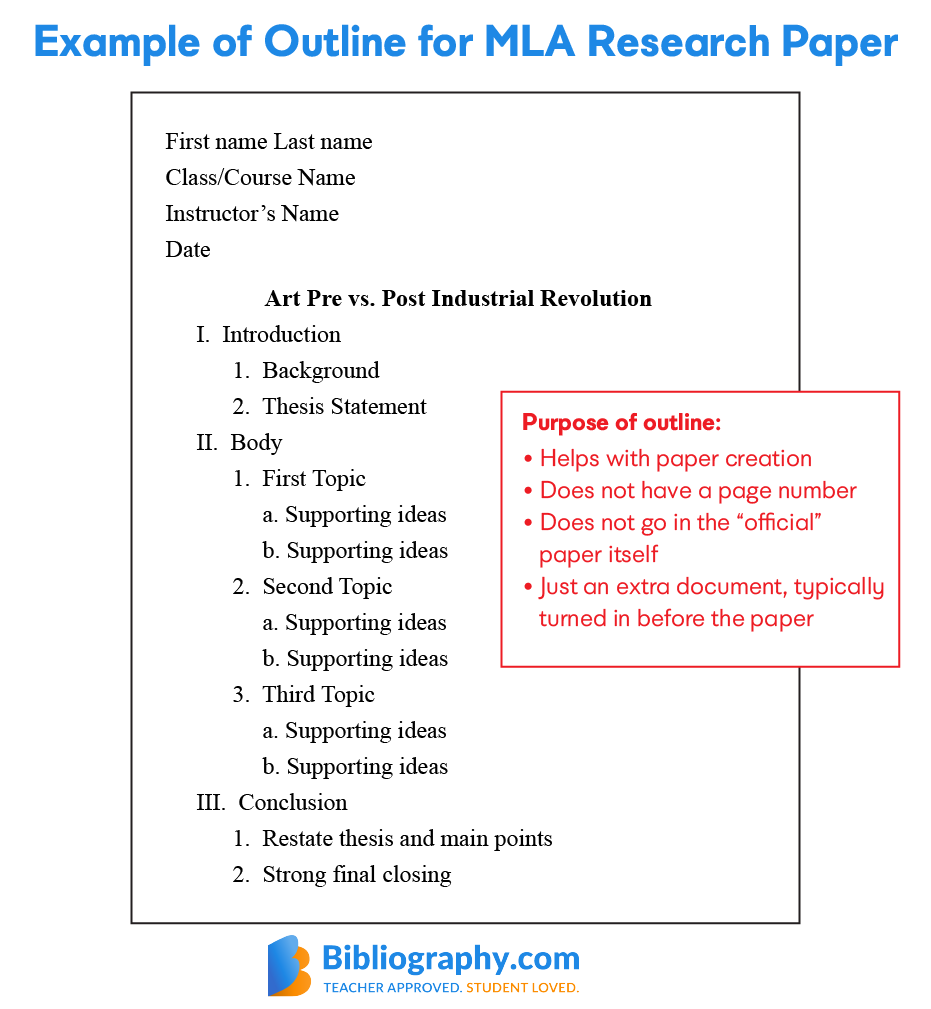
Formatting an MLA Paper
With all your research at your fingertips, it’s time to start formatting your MLA paper. To keep you from going rogue, MLA format has a specific page layout. And you’ll want to follow it to the letter… and period.
MLA Format Heading & Title
MLA format has basic requirements you must follow when it comes to creating your paper heading and title. While not an all-inclusive list, a few things that you need to keep in mind include:
- Your name should be on the left.
- The title of the paper is centered.
- Include a header for the running name and page numbers.
- Use a readable font in a standard size. Times New Roman in 12 pt. is recommended.
While MLA offers a lot of flexibility in their style, formatting it correctly is essential.
MLA Format Cover Page
MLA is one of the more flexible formats; therefore, you might not need to format a cover page. However, if your teacher requires one, a guide for formatting your cover page can make your world a whole lot easier. Make sure to follow all the margins, indents, and text format recommendations. Remember, this is the first page your teacher will see, and it sets the tone for your entire work.
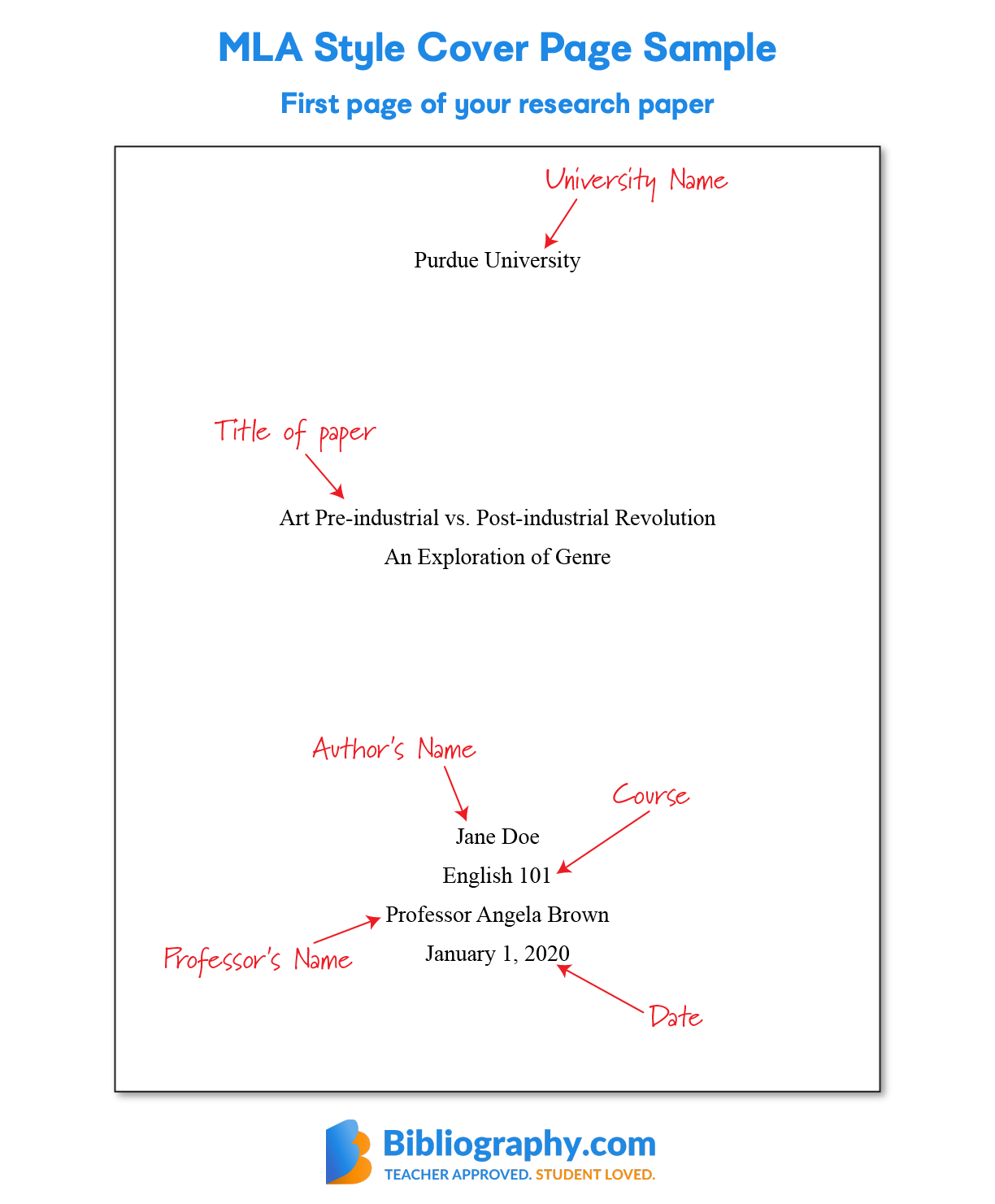
Numbers in MLA Style Format
MLA formatting likes to keep things simple when it comes to formatting numbers. And for that, you should be thankful. In terms of writing numbers using MLA style, depending on the number, you might be using Roman or Arabic numerals and writing them out in full or using the numerical form. It is all going to depend on what the number is and where it is going. Technical reports tend to use numerals, while numbers that can be spelled in a word or two are typically written out in full.
Abbreviations and Acronyms
Abbreviations and acronyms also have a specific format in MLA style. This includes how you abbreviate postal codes, names, and even volumes. Just follow the MLA recommendations, and you won’t have any issues.
MLA Style Images and Tables Guide
Images and tables can make your paper shine. However, you can’t just place them anywhere.
As best you can, keep images and figures reasonably close to the relevant text. This way, the images can work to illustrate your point. Your image is flush left and labeled with any notes. For example: Fig. 1: A research image. You’ll be more descriptive, but this gives you the general idea.
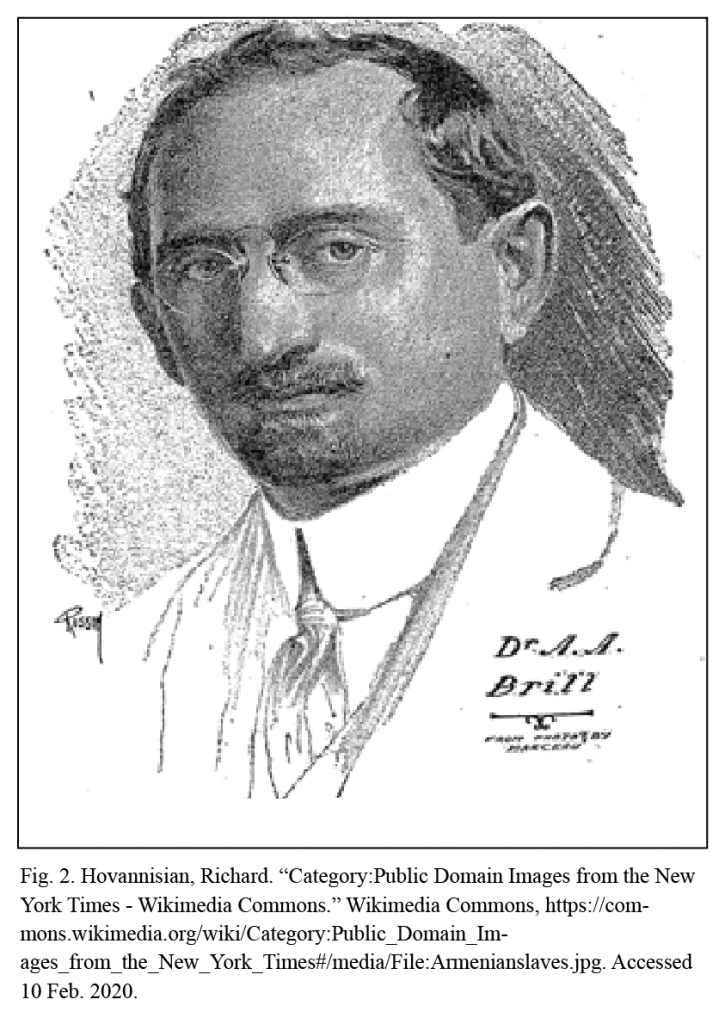
Tables have a label that goes along with them, like Table 1, as well as a descriptive title. They are sourced with an explanation below, just like an image.

MLA In-Text Citations
When you cite work in the body of your paper, MLA in-text citations follow the author-page system. This tells you that you should include the author and page number in your in-text citations.
Setting Up In-Text Citations
When setting up your in-text MLA citations, include the author and page number (Ceasar 23). That’s it! Whether you’re paraphrasing, using short quotes, or even a long quote, you just need to put in who the author is and the page the information can be found on. It’s that simple.
Poems or Verse in MLA Style Format
Since MLA is designed for language arts essays, you’ll likely need to include a poem or verse in your paper at some point. Thankfully, MLA citations prepare for that. To keep everything all nice and tidy, include poetry using the MLA block quote format. This will just make your text stand out.
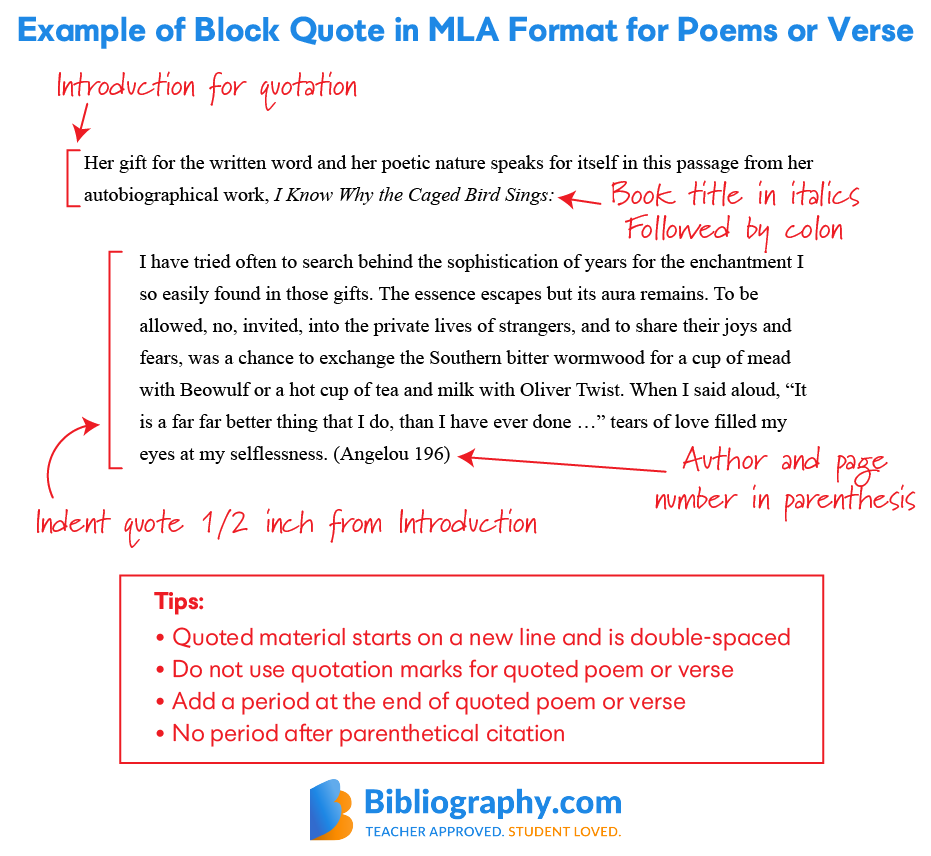
Why Are MLA In-Text Citations Important?
MLA parenthetical citations are essential because they give credit where credit is due. If you don’t, then you are plagiarizing someone else’s work. To avoid plagiarism and a potential F, you need to make sure that you are citing any ideas that are not your own or aren’t common knowledge. Common knowledge is something like, “The president lives in the White House.” Everyone knows this, so it isn’t something that you would have to cite. MLA citations also allow readers to find the sources you used to write your paper in your references.
MLA Citations: Works Cited Page
In-text citations are important, but so is your MLA works cited page. This is the MLA version of a bibliography. However, a works cited and a bibliography have a few key differences, like their titles, how they are set up, and what sources to include. Make sure to set up a works cited for your MLA paper.
Formatting an MLA Works Cited
The format of your MLA works cited is broken down for you in the MLA style guide, including punctuation, hanging indents, alphabetizing, and arranging numbers. The organization of an MLA works cited entry is broken down into nine core elements, simply called the MLA core elements. Having these nine elements clearly written out takes away any guesswork when formatting an entry. But, just to make it clear, sometimes it is easier to see a works cited example in action.
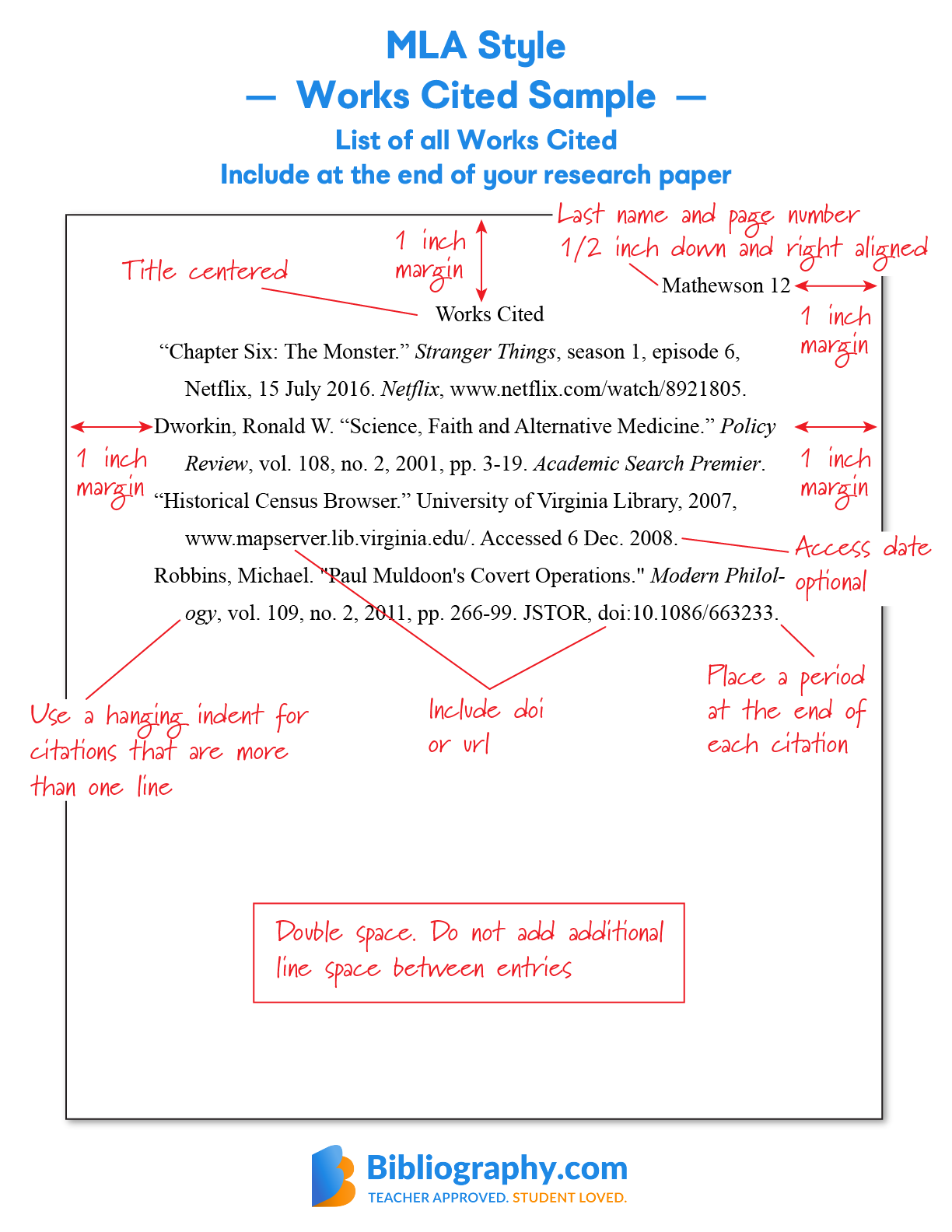
MLA Format Container Style Guide
When creating your MLA format citations, you might notice the words “MLA containers.” In the MLA core elements, the third through ninth elements make up the containers in an MLA citation.
Containers are an easy way to account for how your source material may come in different formats with different elements. MLA was trying to make a format that could withstand the changing times, particularly for internet sources. The container elements include such information as the version number and publication date.
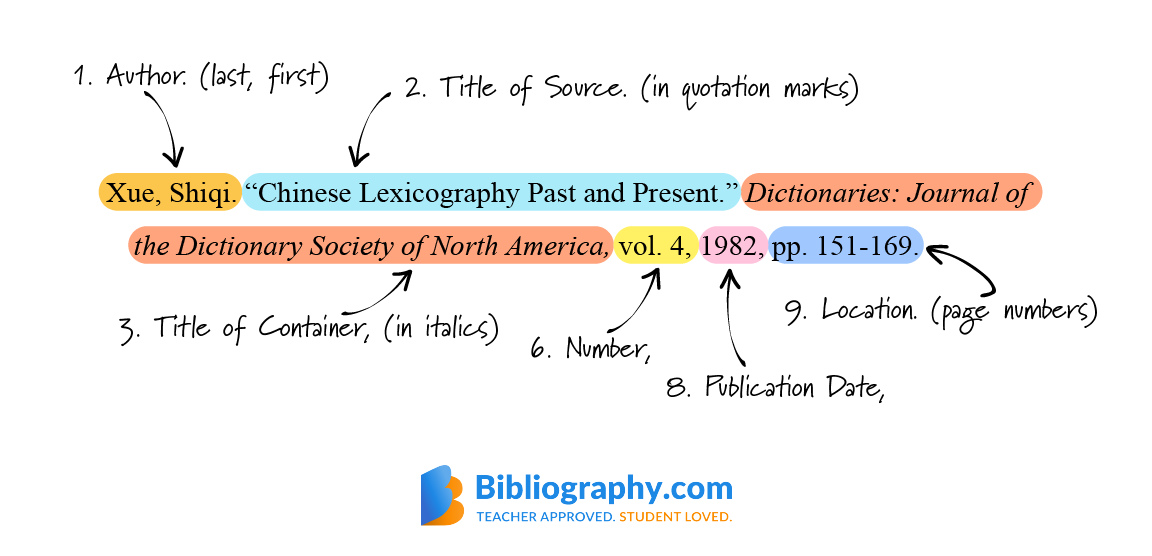
Citing Books in MLA Format
When it comes to creating your works cited entry for books, you want to include the author’s name (last, first), the book’s title, publisher, and publication date. You may also include the publication location, as appropriate.
This is also going to vary slightly depending on if your book had one author or multiple authors. The quick way to break this down is:
- One Author: Last Name, First Name.
- Two Authors: Last Name, First Name, and First Name, Last Name.
- Three or More Authors: Last Name, First Name, et al.
This can get a bit more complicated for works like the Bible with no author, as well as for anthologies, but this is the basic formatting of an MLA book work cited entry.
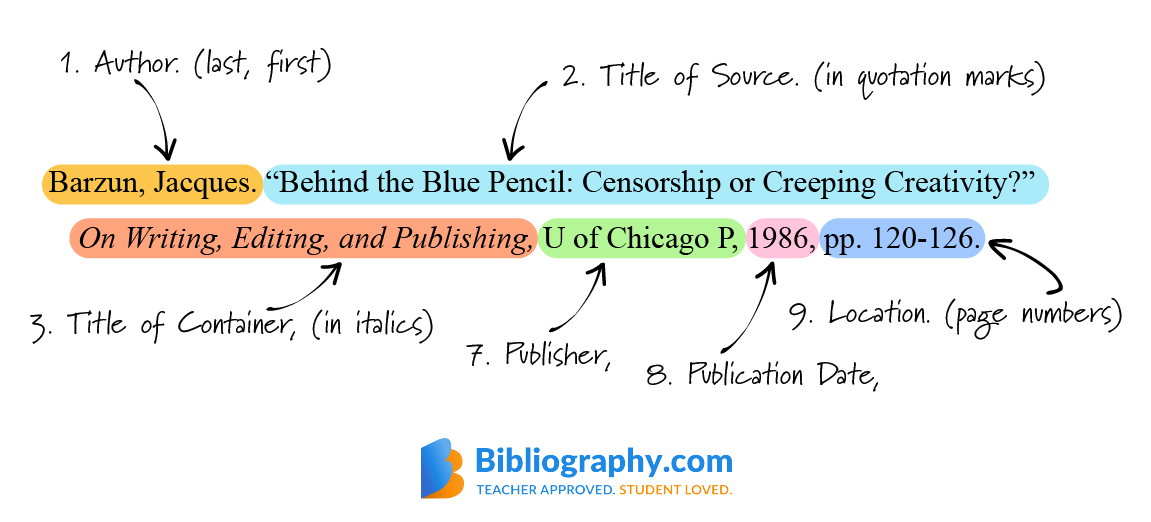
MLA Website Citations
Just like anything else, the key to getting your citation right for websites and other digital media, like digital videos, films, and movies, is to use the containers that fit with your source. This means that each type of works cited entry is going to have a unique citation.
Website Example:
Marble, Dee. “Jealousy in Shakespeare.” Shakespeare Online. 15 Aug. 2020, shakespeare-online.com/quotes/shakespeareonjealousy.html.
MLA Format Periodical Citation
Books are one thing, but periodical citations in MLA are a whole separate beast to tame. A periodical is anything that is published regularly, multiple times a year. This could be a magazine, newspaper, or a monthly journal. Periodicals come in all shapes and sizes. You can even use the introduction of a scholarly journal article as a source.
When you are citing a magazine or newspaper, the container system of MLA comes in handy. You can include anything from author, title source, container title, contributors, version, number, publisher, publication date, location, and the page number. What you include is going to depend on what is available.
Newspaper Example:
Met, Theresa. “Local Boy Charged With Possession.” Albuquerque Journal, 4 Nov. 2020, A2.
MLA Citations for Shakespeare and Poems
It wouldn’t be an MLA paper without Shakespeare and poetry citations! The good news is that creating a citation for Shakespeare’s work isn’t difficult. However, it does get a bit tricky depending on what you’re citing. For example, if you are talking about Shakespeare himself, then you include his name first. But if not, then the work goes first.
Shakespear Example:
Shakespeare, William. Romeo and Juliet. Edited by Howard H. Furness, 6th ed., vol. 9, Classic Books Company, 2001, Google Books.
PowerPoint Citations in MLA Style
You wouldn’t think that you would include many PowerPoint presentations in your works cited, but it happens more often than you might imagine. With professors putting their lecture notes online, this can be a great way to get an excellent primary source. Remember to pay attention to the core elements and container system when citing a PowerPoint presentation.
PowerPoint Example:
Ren, Tor. “Capitalism a Tool.” Philosophy 101. 12 August 2016. Fictional University. Lecture.
Other MLA Style Guide Citations
Some other MLA citations you need to make might not fit into a typical category. Don’t be worried that you’ll get it wrong. Like you’ve learned already, MLA is flexible when it comes to citing interviews and images. As long as you follow the rules of the core elements and the container system, you are golden.
Free MLA Citations Through an MLA Citation Generator
Even with the core elements system, an MLA citations generator can be an easy and free way to create MLA citations in minutes. Rather than try to figure it all yourself, you can put your works in the generator, and your citation is generated in seconds. Then all you have to do is copy and paste it into your works cited, and you’re done. Simple, right?
Footnotes in MLA Format
MLA format discourages the use of footnotes, if possible. However, sometimes, you need to add them to the text to provide more information. The two instances where you will use footnotes in MLA style include content notes and bibliographical citations. Contents notes are for long citations that might clutter up the body of your paper. Bibliographical citations clear up convoluted citations.
MLA Annotated Bibliography
It’s not common, but you might be asked to create an annotated bibliography in MLA format. Rather than start to sweat, know that you already have the basics in the bag. In addition to creating your standard citation, you create either a summary annotation or evaluative annotation for each source. This just provides your professor a bit more information on your sources.
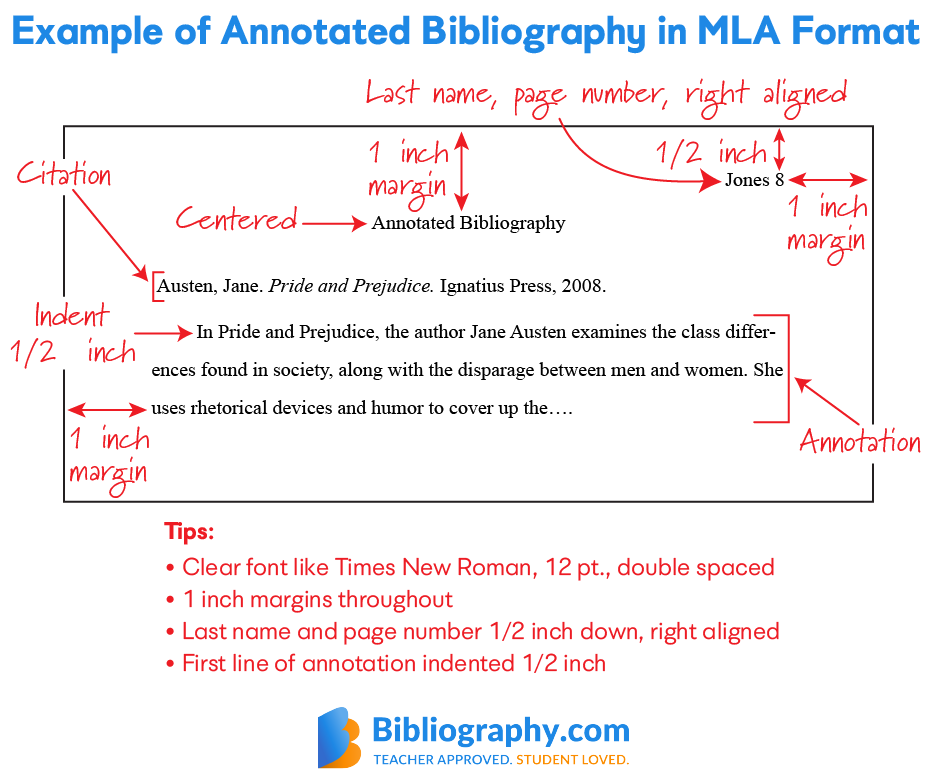

Getting a Handle on MLA Format and Citations
MLA style format and citations offer a lot more flexibility than you might find in APA format or Chicago style. However, there are still rules you need to follow when creating your paper. As long as you are careful to mind your margins and indents, you are set to go.
FAQ MLA Format and Citations
What is proper MLA format?
To understand proper MLA format, you need to look at the style guide created by the Modern Language Association. The MLA style guide breaks down the formatting requirements, in-text citations, and works cited for creating your language arts, liberal arts, or humanities paper.
How do you write an MLA citation?
To write an MLA citation, you use the nine elements laid out by MLA including author, the title of the source, title of the container, other contributors, version, number, publisher, publication date, and location. You only include the elements that you have information for in your MLA citations.
What are the steps to MLA format?
The steps to creating a paper in MLA format start with setting up your paper using a running header that is right-aligned and includes your name and page number, 1-inch margins, a readable font, double spacing, indents for new paragraphs, and one space between sentences. MLA also offers instructions for how to format your in-text citations and works cited page.
What does MLA style mean?
MLA style means you're using the style guide established by the Modern Language Association. The MLA style guide offers the flexibility and formatting necessary to easily create papers on humanities, arts, and language arts.
Who uses MLA style?
The MLA style can be used by any professional or student creating a research paper, essay, or project. However, the MLA writing style is the preferred style used by high schools because of the flexibility in formatting online sources.


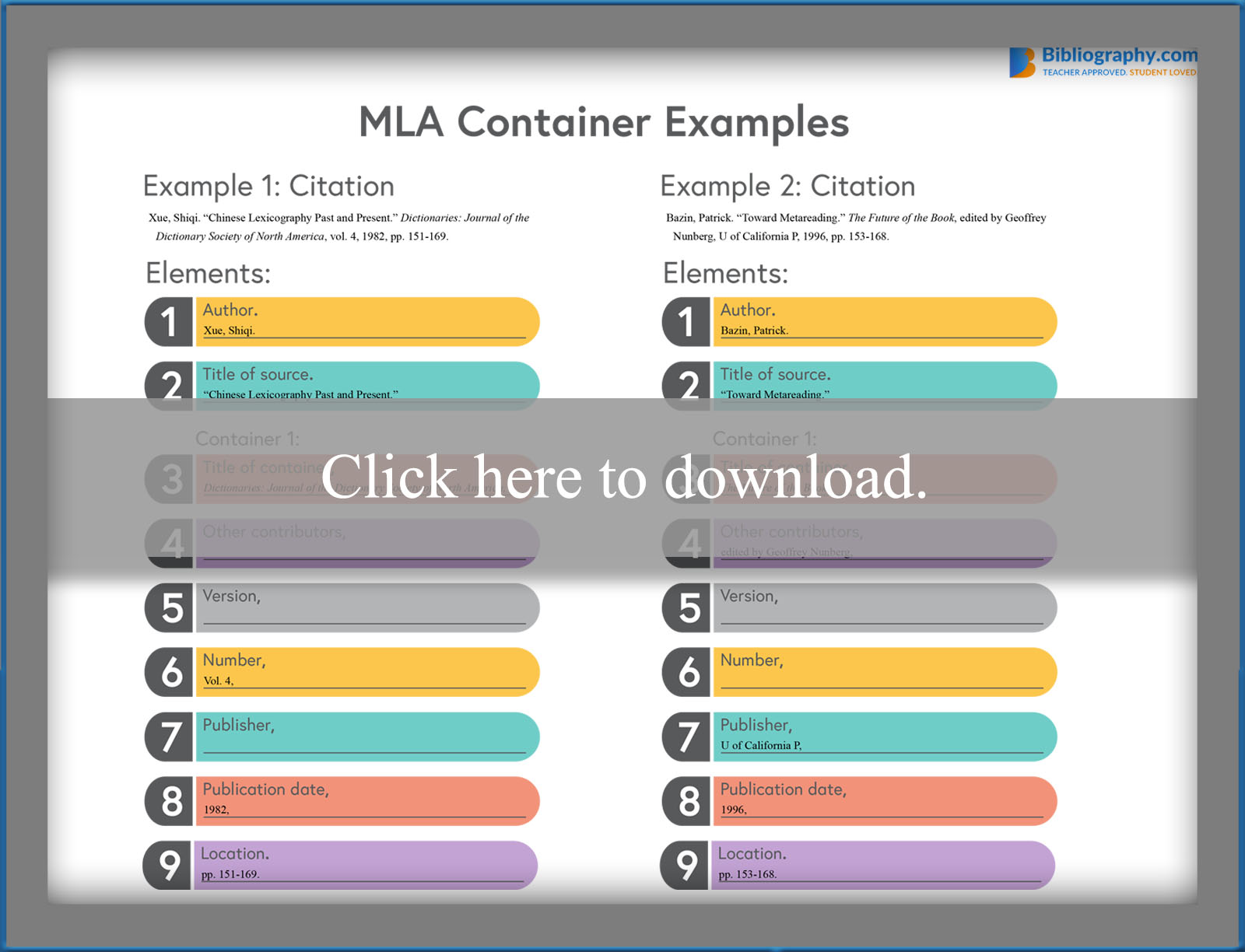
What’s “MLA”?